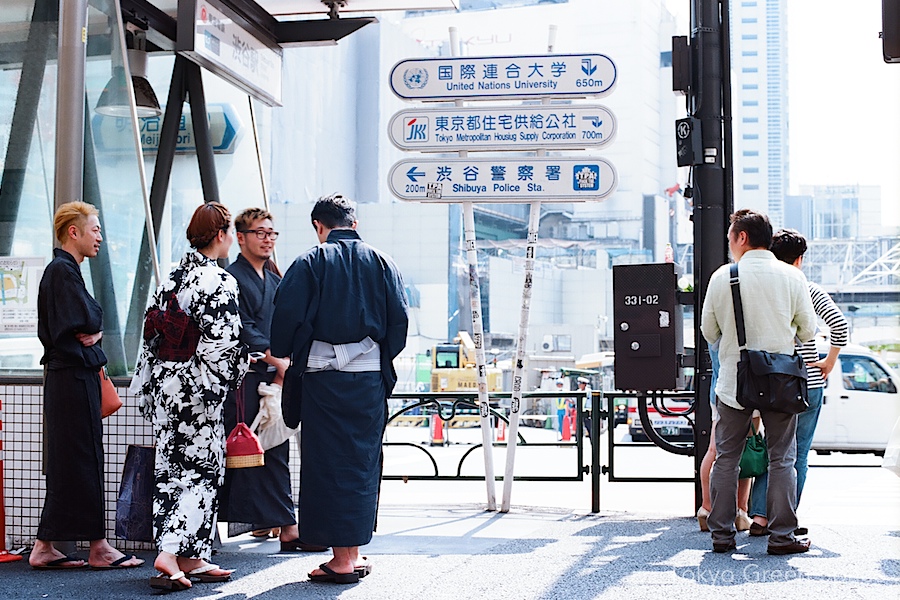
Is it the ribbon tied in the back? Summer yukatas are the best. Maybe not the most practical clothing, but certainly stylish and elegant. I momentarily forgot I was at Shibuya station.

お正月が終わったら、日常生活が戻ります。このメトロの写真に、男性はみんな黒いスーツを来ているので、庭のより東京人のほうがもっと型にはまっていると思います。
Uniformity and order can be even more stylized in Tokyo human environments than gardens. How is it that every passenger in this frame is a man in a black suit? Can that small screen transport us somewhere more magical and more vivid than our surroundings?

3.11の一年目の追悼と反原発のヒューマンチェーンに参加して、写真をたくさんとりました。高齢者が多くて、コズプレもあって、悲しく、同時に色がたくさんありました。ポケモンを何人か見ました。数万人が国会議事堂を囲んで、非常に感動しました。
On the first anniversary of the March 11, 2011 earthquake, tsunami and nuclear disasters, I spent the afternoon at a memorial in Hibiya Park, and then joined tens of thousands forming a human chain around Japan’s national assembly, the Diet. I snapped a lot of photos, along with @sub_fauna, who took some great photos.
It was great to see so many people coming together to ask for fundamental change to energy and politics. Striking were the number of seniors, the odd costumes including several Pokemon, the mix of the mournful and colorful. A few Japanese friends asked me what a “human chain” was, as if it were a complicated imported notion. It was very touching to see people holding hands around the center of government.
I was also impressed with how organized the entire demonstration and policing were. The long cross-walk in front of the Diet was occupied only while the light was red. The police remained very calm, and their main tools were rolls of neon police tape, megaphones, and fabric traffic barriers with rings for lines of police to easily hold.

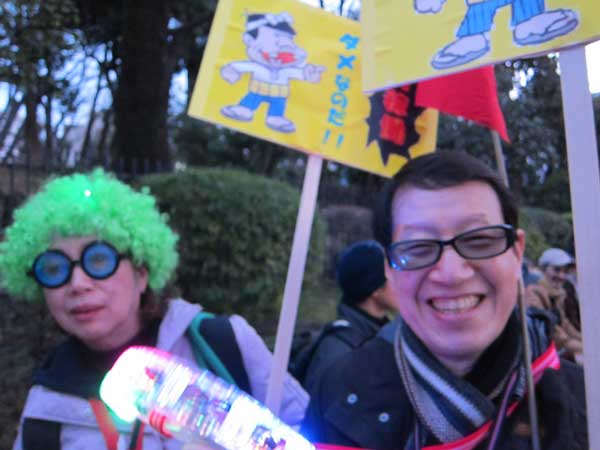



私のアパートの近くにきれいな木造の家があります。自然と近所の人たちのおかげで、この景色は元気です。
Just three days after the earthquake and radiation leakage, I noticed the very elderly security guard at the supermarket loading area applying a pruning saw to a tree across the alley. The tree was part of the landscape outside a beautiful abandoned wood house. The guard did a skillful pruning job. It seemed a strange gesture given the uncertainties and shortages at the time.
The wood house is one of the few pre-war structures nearby, and whatever plants are in front survive because they are extremely hardy and suited to Tokyo’s climate. Once the potted tree had been pruned back, I could see clearly that the pot was split down the middle, the roots circumventing the asphalt, and the tree naturalized in the city. The abandoned house and garden are a small neighborhood treasure. I also love the thick row of ferns, the multi-level racks with potted plants, and how the front entrance has turned into a small jungle.
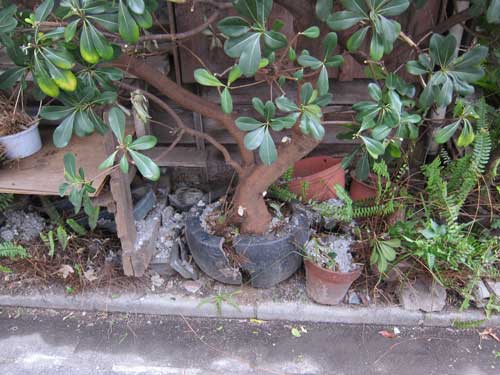

だれも都会のキノコの誘惑に勝てない。
Who can resist urban mushrooms?
My architect friend James Lambiasi sent me this photo of Nakameguro mushrooms on a second floor balcony. Do these mushrooms apply to landscape, he wondered? Of course, nature is no less splendid when touched by humans. This lovely, jumbled cityscape- of power lines, bicycles, laundry, exhaust pipe, paper lantern, and fall foliage- is a perfect frame for a double mushroom table and chair set. Thanks, James!
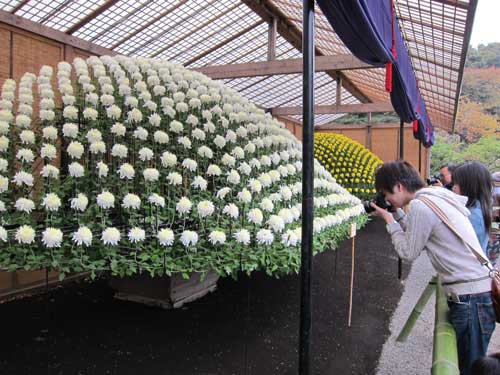
These giant chrysanthemum displays are a marvel of human manipulation of nature. Called an “ozukuri bed” (大作り花壇), this technique for pinching, pruning and training chrysanthemums (菊) originated in Shinjuku Gyoen in 1884. In the first half of November, it’s a featured display each year.
On a conceptual level, I love the orderly rows that transform nature into a skilled craft. And I know that chrysanthemums are a national symbol of Japan. Yet, however monumental and transitory, I fail to find these flowers beautiful. What do you think?
There’s another style where the chrysanthemums are trained to look like a cascading river of petals. I like how they are in special bamboo huts with blue curtains and red tassels.
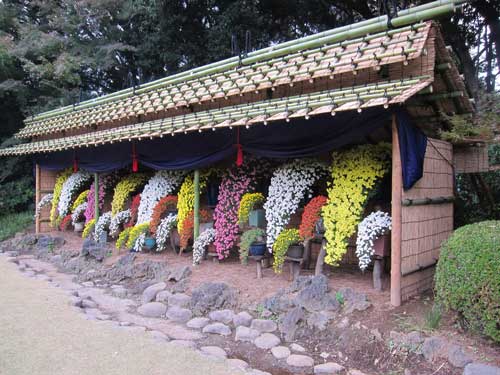

Tokyo University is hosting a symposium next month on Biodversity and Sustainability. It promises “a multi-faceted exploration of how to assess and rebuild traditionally human nature relationships into modern sustainable social systems.”
Speakers include Tokyo University professors, government leaders, and international researchers. You can see the program online (in English and Japanese) and fill out a free online registration (Japanese only). The sponsor is IR3S, or the The Integrated Research System for Sustainability Science.

The City of San Francisco has created a cool program encouraging people to adopt at San Francisco street tree for Christmas instead of purchasing a dead pine tree. City residents can choose between Southern Magnolia, Small Leaf Tristania, Strawberry Tree, and New Zealand Christmas Tree. For US$95 you can pick up a 2 meter potted tree in early December. The trees will be planted on San Francisco streets after the holiday, and adoptive families are invited to help.
This is a smart idea to eliminate the waste of traditional Christmas trees and to involve residents in a very personal way with the city’s goal of doubling its 110,000 street trees. The website has great links to learn more about the human benefits of urban trees, and the current and historical state of San Francisco’s urban forest.
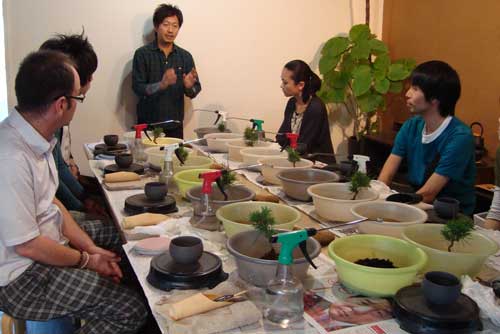
Recently I had the pleasure of taking Kobayashi Kenji’s modern bonsai class at Sinajina. In addition to making my own miniature landscape with a black pine, rock and moss, I learned that gardening in October is focused on making plants beautiful for New Year’s celebrations and guests.
The class used eight year old black pine trees. First we removed all the old, longer pine needles by hand and with tweezers. We removed nearly all the old soil to replace it with a fresh mix that includes volcanic rock and to expose some of the oldest roots at the base of the trunk. Then, we examined the tree to identify its “face” and position the tree in its new pot. Finally we added moss– in my case a taller hill that passes underneath one of the roots and a lower meadow– and small rocks.
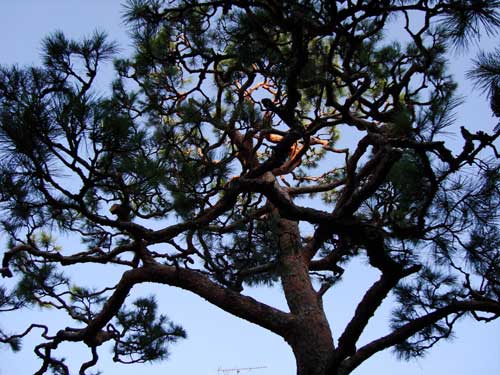
Careful attention to form and style is clearly something that extends from miniature landscapes to residential garden landscapes. I am sure that many home-owners and gardeners are pruning their trees now to make sure that they are spectacular at New Year.
I also learned how to distinguish between black pine and red pine. Black pine needles are hard, unbending and sharp, while red pine needles are much softer to touch. Only when fully mature do red pine trees exhibit the bright red trunk that also distinguishes them. Black pine trees are mostly found near the sea, whereas red pine trees grow in the mountains.
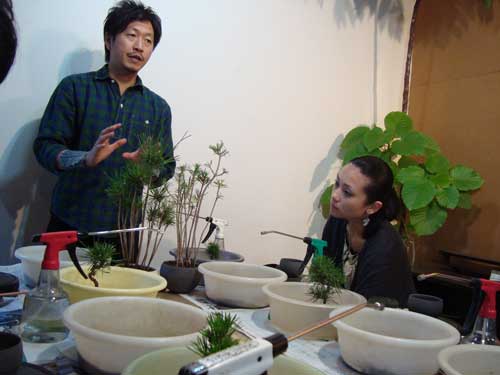
Kobayashi sensei continues to be an inspiring guide to plants in urban life. In his anthropomorphism, plants become more human, and humans more embedded in nature. Plants are like people, he explains, in that they require most care during their first year, including more water. Once domesticated, plants cannot be returned to the wild since they have lost their survival skills and require continued human care.
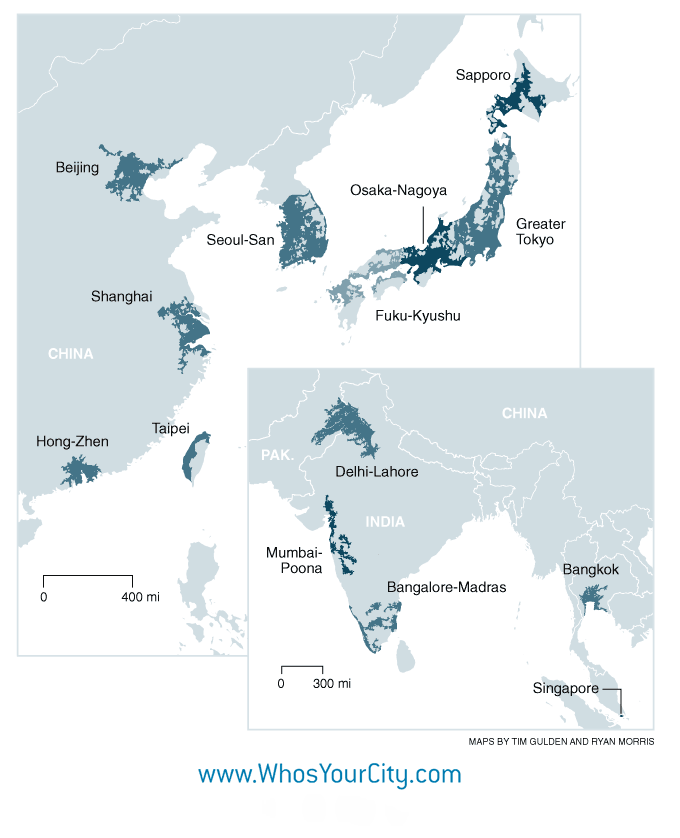
I read Richard Florida’s 2008 Who’s YOUR City? book, a “self-help” book about the central importance of where we live and the outsized opportunities in the world’s leading mega-cities. Drawing from Jane Jacobs and a wealth of statistics, Florida analyzes how the world has become “spiky” with concentrations of innovation and economic activity in mega-regions. Despite globalization and technology, place has become ever more important for individual happiness and economic growth.
For individuals, Florida argues that the choice of where to live is the biggest factor in our lives, happiness and communities. And for urban leaders, his writing and consulting describes how to become a magnet for the creative class and economic growth by promoting the arts, tolerance, talent and technology.
Tokyo is the largest mega-region, with 55 million people, and appears to far exceed all other mega-regions in the innovation map below. There are many other interesting maps on his website, although heavily focused on the United States and Canada.

Since Florida is increasingly focused on sustainable urban living, it would be interesting if he can correlate urban plant and biodiversity levels with human happiness and economic activity. Somehow I imagine this is a topic he will be investigating soon.

Spring in Tokyo reminds you of the power that flowers have to capture human imagination. Cherry blossom viewing, which has its own name in Japanese, hanami (花見), draws people to socialize outdoors, drinking and eating on blue tarps with family, friends, co-workers and neighbors.
The power of cherry blossoms (or sakura, 桜) even inspires acts of seeming recklessness. In the photo above, an older salary man is perched precariously above the Imperial Palace moat in his quest to take a close-up photo with his cellphone (or ketai).
As an anthropologist and foreigner in Japan, it is also striking to me how specific flower devotion in Japan is. On a hanami stroll, I noticed this beautiful yellow flowering bush called yamabuki, literally “mountain spray.” I have never seen it on either coast in the United States; an internet search gives its English name “kerria.” Despite the crowds in the Tokyo park, I felt that I alone was giving this flower some attention.

At the end of this month, Good Day Books in Ebisu, will be hosting an author’s reading with Enbutsu Sumiko. Her Flower Lover’s Guide to Tokyo offers 40 walks in Tokyo focusing on seasonal flowers in various parks and gardens.
